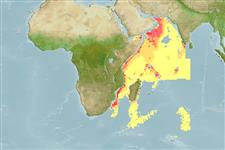Elasmobranchi (squali e razze) (sharks and rays) >
Pristiophoriformes (Saw sharks) >
Pristiophoridae (Saw sharks)
Etymology: Pristiophorus: pristio-, presumably derived from prio (Gr.), to saw, but treated here as a noun (a saw); phorus, from phoreus (Gr.), bearer or carrier, referring to saw-like snout (note also that pristis is Greek for sawfish). (See ETYFish); nancyae: In honor of philanthropist Nancy Packard Burnett (b. 1943), co-founder of the Monterey Bay Aquarium (Monterey, California, USA), for her “gracious support” of chondrichthyan research at the Pacific Shark Research Center at Moss Landing Marine Laboratories (also in California). (See ETYFish).
Environment: milieu / climate zone / depth range / distribution range
Ecologia
marino; distribuzione batimetrica 286 - 570 m (Ref. 97326). Tropical
Western Indian Ocean: central and southern Mozambique (Ref. 87357). Off Kenya and Yemen (Socotra Islands) (Ref. 97326). Records from off Somalia and the Arabian Sea off Pakistan appear to be a different, possibly undescribed, species (Ref. 87357).
Length at first maturity / Size / Peso / Age
Maturity: Lm ? range ? - 57 cm
Max length : 61.6 cm TL maschio/sesso non determinato; (Ref. 97326); 62.1 cm TL (female)
Short description
Chiavi di identificazione | Morfologia | Morfometria
Vertebre: 132 - 139. Diagnosis: A small five-gilled sawshark distinguished from its congeners by having the following characteristics: the presence of two rows of enlarged pre-barbel pits on the rostral ventral surface; rostral barbels closer to mouth than snout tip; base of large rostral teeth with ridges; eyes very large, oval-shaped, emerald green in life; first dorsal fin broadly triangular, with rear tip extending behind pelvic fin midbases; lateral trunk denticles imbricated; colouration in life brownish gray laterally, becoming lighter ventrally; fin margins lighter along posterior edges; dorsal rostrum surface with two distinct longitudinal dark stripes; lateral rostral teeth dark-edged (Ref. 87357).
This species is a poorly known inhabitant of the upper continental slope in tropical waters found at depths of 286-500 m (Ref. 87357). Stomach contents include an unidentified organic material, partially digested shrimplike crustaceans, and small decapod shrimps; no fish or cephalopod remains were found (Ref. 87357). Larger individuals had small puncture marks and elongated parallel cuts on their backs and tails suggestive of combat injuries from the rostra of other sawsharks (Ref. 87357). Unknown litter size; it may be caught and discarded as bycatch by offshore shrimp trawlers and other deepwater fisheries operations off Mozambique (Ref. 87357).
Life cycle and mating behavior
Maturities | Riproduzione | Spawnings | Egg(s) | Fecundities | Larve
Ebert, D.A and G.M. Cailliet, 2011. Pristiophorus nancyae, a new species of sawshark (Chondrichthyes: Pristiophoridae) from Southern Africa. Bull. Mar. Sci. 87(3):501-512. (Ref. 87357)
IUCN Red List Status (Ref. 130435)
Threat to humans
Harmless
Human uses
Strumenti
Special reports
Download XML
Fonti Internet
Estimates based on models
Preferred temperature (Ref.
123201): 9.8 - 12.4, mean 11.4 °C (based on 18 cells).
Phylogenetic diversity index (Ref.
82804): PD
50 = 0.5156 [Uniqueness, from 0.5 = low to 2.0 = high].
Bayesian length-weight: a=0.00389 (0.00180 - 0.00842), b=3.12 (2.94 - 3.30), in cm total length, based on all LWR estimates for this body shape (Ref.
93245).
Trophic level (Ref.
69278): 3.8 ±0.6 se; based on size and trophs of closest relatives
Fishing Vulnerability (Ref.
59153): Moderate vulnerability (45 of 100).
